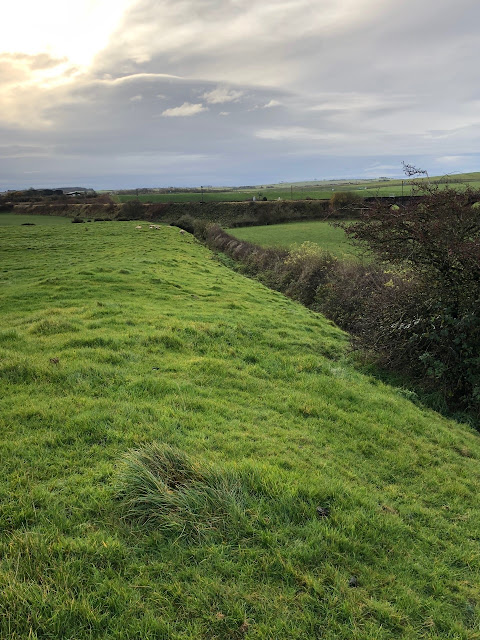Blatobulgium Roman
fort. A desperate last stand?
At some point around AD 155 the Roman fort of Blatobulgium was destroyed.
The Roman army when abandoning one of its castra would, as a matter of good military practice and in an orderly manner, demolish the defences in order to deny them to the enemy. However this does not appear to be the case in regards to Blatobulgium (Birrens, near Ecclefechan, southwest Scotland). Archaeologist Anne Robertson, who spent an extended period exploring the site concluded:
‘In the absence of definitive evidence at Birrens, the impression can only be recorded after months spent in observation and study of the demolition and wreckage, that the driving force seems less likely to have been Roman and orderly, than savage and wayward.’
Even before I began writing my Roman historical adventure novel ‘Siege’, I had in mind Birrens as one of the principal locations for the story. But it was only in the research phase that I realised what a special site it was.
The fort lies on a plateau about 200 ft above sea-level, at the junction of the Mein Water and the Middlebie Burn and around 26 miles north of Hadrian's Wall. An excellent defensive position. There had been a fort there since the time of Agricola’s campaigns in North Britain, but it is its role in the first decade or so of the rule of Emperor Antoninus Pius that appears to have been pivotal.
In around AD 142 the Hadrianic period fort was flattened and the site extended. The internal buildings were rebuilt of beautifully finished stone work, possibly by a detachment of the Sixth Legion. It had six ditches on its northern side and unusually three granaries, one double sized, likely accounting for its name Blatobulgium (flour sack).
Its garrison too was
unusual. The First Nervana Germanorum, an auxiliary unit raised in
the lands of the fierce Nervii tribe in modern day central Belgium.
It was a milliaria equitata, a double strength, mixed cohort of
roughly a thousand men. 240 were mounted, in turma’s of 30
troopers, and 800 infantry, in ten centuries. Milliaria equitata were
formed for specialist purposes and were usually led by a veteran
tribune and a Roman citizen. But what was its purpose? Why were the
First Nervana there?
 |
| Pics of the fort today, now a sheep field, but some of the ditches and ramparts are still visible |
This is where some context is useful. Around the same time as Blatobulgium was being rebuilt, the Roman frontier in Britannia had moved northwards from Hadrian’s Wall to the Clyde-Forth isthmus in modern day central Scotland and a new wall built by Quintus Lollius Urbicus under the auspices of his new emperor. The garrisons on Hadrian’s Wall would therefore have been denuded. Perhaps crucially, the enlarged fort sat roughly at the meeting place of three tribal lands of the Novantae, Selgovae and Brigantes. The latter’s lands were south of the original frontier.
The Iron Age hillfort of Burnswark too lies four miles north of Blatobulgium. Archaeological evidence is compelling that an assault of the hill was mounted by the legions against a force of local tribesmen, possibly at the beginning of Pius’s reign. It would appear that the tribes in this part of Britannia were ever warlike and restless.
The fort and its garrison would therefore have had a significant peacekeeping role. This is where the enlarged cavalry force of the cohort would have come into its own. Cavalry could move at lightning speed, and were highly mobile, making them effective on patrols and as scouts in remote areas. They made speedy messengers, giving warning of sudden threats and incursions. As well as helping to collect taxes from local chieftains. But they would also ensure food security. Blatobulgium was not entirely on its own, but rather, given its multiple granaries, may have acted as a hub supply base for other smaller forts, fortlets and watchtowers in the region. But most significantly, the cavalry projected the image of power and renown of Rome and its imperial might. If you have ever seen the Household Cavalry in London or mounted police outside of a football (soccer) stadium you will get an idea of what a Roman turma must have looked like to an Iron Age population.
So what happened to the fort? Was the garrison assailed by a massed and combined army of tribesmen like some kind of ancient Alamo? Or did the First Nervana leave in an orderly manner and the local warriors set it afire afterwards? We will never know. All we can say with a degree of certainty is that in around AD 155 Blatobulgium was destroyed in a savage and wayward manner.
But, authors of ancient historical fiction live in those areas of uncertainty. It means we are able to ‘pick a side’, treading in places where it is difficult for Archaeologists and Historians to go. And, in Siege, I have picked my own side.
Amazon
US https://www.amazon.com/dp/B09SLWHP8T
UK https://www.amazon.co.UK/dp/B09SLWHP8T
Twitter: @alistair_tosh
Bio
Alistair lived in the Dumfriesshire countryside for most of his childhood. A region of Scotland filled with ancient place names such as Torthorwald and Caerlaverock. But it was his history teacher’s telling of the tale of Burnswark and the Roman siege of the Iron Age hillfort that fired his love of Roman and Dark Ages history. From there the kernel of the stories for the Edge of Empire series took root.
On leaving school he began a 35-year communications career, firstly with the Royal Navy, that included covert riverine and seaborne operations during the height of ‘The Troubles’ in Northern Ireland, before moving into the corporate world. Military life is unique, and Alistair aims to reflect an authentic view of that experience and its language in his stories. When not writing or spending time with family, Alistair, his wife Jenny and Hurley the cockerpoo love to walk in the hills of both the UK and Andalucia.



No comments:
Post a Comment